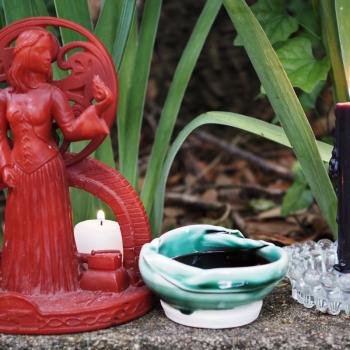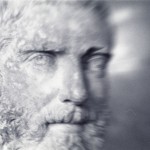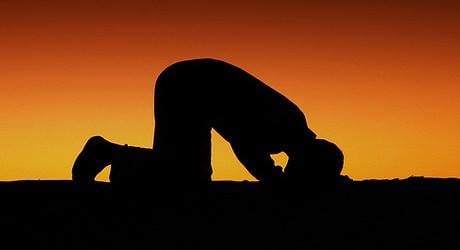[Revised 2/27/14]
So here is my evening practice, which I do in front of my altar at home. My morning ritual is focused on the natural elements: air, sun, water, dirt. But my evening ritual is focused instead on inner archetypes. This makes sense to me since, in the morning I am preparing to head out into the external world, whereas at night, I am leaving that world for the inner world of dream.
First, I have to explain how my altar is set up. The left side of my altar is occupied by symbols of the masculine divinity and the right side by symbols of the feminine divinity. With the masculine symbols are a green candle and black candle, representing the Green Horned God (“The Green and Amber Man”) and the Dark Horned God (“The Loathly Man”). With the feminine symbols is a red candle, representing the Goddess (“The Scarlet Woman”). Wrapped around the base of the red candle are three cords: gold, green, and black, representing the relationship of the Goddess to the God as mother/son (gold), lovers (green), and slayer/victim (black).
I begin my evening ritual in the dark. (I make sure I find the lighter beforehand so I don’t have to fumble around in the dark.) First I light the black candle, and recite a line from Ahab’s monologue to the lightning in Moby Dick:
Thou art light leaping out of darkness, but I am darkness leaping out of light, leaping out of thee.
This is a reference to the dual nature of the God, light and dark.
Next, I light the green candle and recite a line from the same monologue from Moby Dick:
Oh thou spirit of fire, thou canst consume, I can be ashes.
This is a reference to the sacrifice of the God and his rebirth.
Next, I light the red candle and recite the following line from the Elder Edda about Gullveig:
Thrice burned they the thrice reborn, ever and anon, even now she liveth.
This is a reference to the eternal round which is the Goddess.
Then I recite the following from a Hasidic story:
This is my sacred fire. This is my holy place. These are the words of my prayer … *
I then express a brief desire to the images of the God and Goddess in the center of my altar. Often my prayer is simply: “Teach me to love this world.”
I then meditate briefly, listening to the silence within.
Finally, I extinguish the candles with the following words from Jacqueline Carey’s fantasy series, The Black Jewels Trilogy:
May the Darkness embrace me.
As you can see, my nightly devotional, like my morning devotional, is very idiosyncratic. Each of the recitations is simply something that I read that stood out to me and my mind drew some kind of connection to my Pagan practice. The ritual as a whole evolved organically and did not come to me as a whole. I have found that doing this at night helps center me and also “sanctifies” my day in a way that is difficult to explain.
I admit, I often retire to bed without doing the ritual. I am uncertain whether I should make myself do it when I am not feeling like it, or whether I should just go with how I feel.
Another problem I have encountered arises from the fact that I share my bedroom with me wife, who is not Pagan. I have felt very self-conscious doing this devotional in front of her. Should I do it earlier in the day, when she is not getting ready for bed? Should I do it while she is in the bathroom? If I do it in front of her, should I announce it in some way? Should I say the words aloud, or just mouth them, or say them in my head? Honestly, I haven’t worked this out yet. The problem might be solved if my altar were not next to our bed, but I like having it there. I’ll let you know when I work this out.
Since first publishing this in 2011, I have added another aspect to my evening devotional. There is a bowl of water that I fill each morning as part of my morning devotional. Before I perform the steps above, I empty the bowl with the following prayer, from “The Garden of Proserpine” by Algernon Swinburne:
From too much love of living,
From hope and fear set free,
We thank with brief thanksgiving
Whatever gods may be
That no life lives for ever;
That dead men rise up never;
That even the weariest river
Winds somewhere safe to sea.
This is a ritual kenosis or emptying, which is intended to help me let go of the day’s preoccupations and also to create psychic space for inspiration through my dreams.
* Note: If you are interested, the full Hasidic story I mentioned above follows:
It is said that when the founder of Hasidic Judaism, the great Rabbi Israel Shem Tov saw misfortune threatening the Jews, it was his custom to go into a certain part of the forest to meditate. There he would light a fire, say a special prayer, and the miracle would be accomplished and the misfortune averted. Later, when his disciple, he celebrated Maggid of Mezritch had occasion, for the same reason, to intercede with heaven, he would go to the same place in the forest and say: “Master of the Universe, listen! I do not know how to light the sacred fire, but I am able to say the prayer,” and again, the miracle would be accomplished. Still later, Rabbi Moshe-leib of Sasov, in order to save his people once more, would go to the forest and say, “I do not know how to light the fire. I do not know the words to the prayer, but I know the place and this must be sufficient.” It was sufficient, and the miracle was accomplished. Then it fell, four generations later, to Rabbi Israel of Rizhin to overcome misfortune. Sitting in his armchair, his head in his hands, he spoke to God: “I am unable to light the fire and I do not know the prayer, I cannot even find the place in the forest. All I can do is to tell the story and this must be sufficient.” And it was sufficient. For it is said, God made humanity because God loves a good story.















